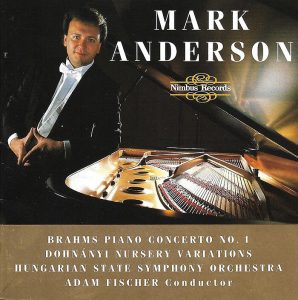Author: Kurth, Richard
Publication details: Music Colloquium Series, University of Western Ontario, London, Ontario
Schubert’s Der Doppelgänger: Reflections and Doubles-Entendues
Brahms, Piano Concerto No.1, Dohnányi, Nursery Variations
Artists: Mark Anderson
Recording details:
“The American pianist Mark Anderson – winner of the third prize in the 1993 Leeds International Piano Competition – is the soloist. He gives a glittering performance of the Dohnányi, and a spontaneous one; he is superbly accompanied by Adám Fischer and the Hungarian State SO.” -Gramophone
Nimbus Records, 2008
Voice Leading as Transformation
Author: Roeder, John
Publication details: Musical Transformation and Musical Intuition: Essays in Honor of David Lewin. Ed. Raphael Atlas and Michael Cherlin. Roxbury, MA: Ovenbird Press. Pp. 41-58.
Weblink: https://books.google.ca
Interacting Pulse Streams in Schoenberg’s Atonal Polyphony
Author: Roeder, John
Publication details: Music Theory Spectrum, Vol. 16, No. 2 (Autumn, 1994), pp. 231-249
Weblink: http://www.jstor.org
Formal Functions of Hypermeter in the Dies iræ of Verdi’s Messa da Requiem
Author: Roeder, John
Publication details: Theory and Practice, Vol. 19 (1994), pp. 83-104
Weblink: http://www.jstor.org
An Introduction to the Music of Milton Babbitt by Andrew Mead (review-article)
Author: Kurth, Richard
Publication details: Integral 8: 147-182
Weblink: www.jstor.org
Kouta and Karaoke in Modern Japan: A Blurring of the Distinction between Umgangsmusik and Darbietungsmusik
Author: Hesselink, Nathan
Publication details: British Journal of Ethnomusicology 3:49-61 (1994)
Weblink: www.jstor.org
Schoenberg and Combinatoriality: Another Perspective
November 1993. “Schoenberg and Combinatoriality: Another Perspective.” Annual Meeting of the Society for Music Theory. Montreal.
Author: Kurth, Richard
Publication details: Annual Meeting of the Society for Music Theory. Montreal
A MaMuTh Achievement” [Review of Guerino Mazzola’s Geometrie der Töne and Gruppen und Kategorien in der Musik]
Author: Roeder, John
Publication details: Perspectives of New Music 31/2: 294-312
Weblink: www.jstor.org
Toward a Semiotic Evaluation of Music Analyses
Author: Roeder, John
Publication details: Music Theory Online 0.5: 1-22.
Weblink: www.mtosmt.org
Abstract:
Eco’s theory of codes provides the basis for analyzing the structure of meaning in three contrasting types of music- analytical representation.An evaluation of the pitch-class- integer code highlights the essential arbitrariness of the links between music and mathematics.Graphical representations of music are also evaluated with reference to a computer program designed to represent musical data in any conceivable graphical form.Lastly the paper postulates conditions under which the literary musical criticism of the Romantic era may have specific musical denotation; accordingly, Schumann’s imagistic review of Schubert’s German Dances, Op. 33, receives exegesis.
